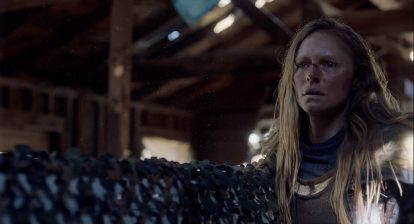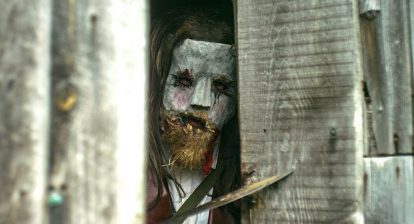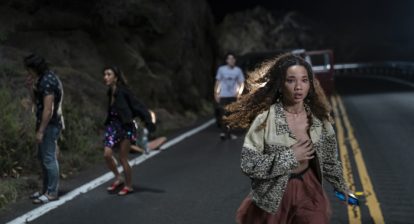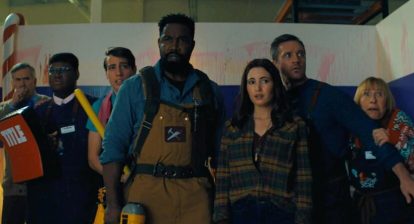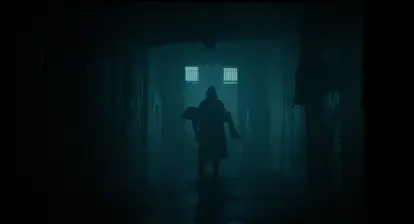When one sees a staircase, terror and fear aren’t the first things that initially come to mind, but when they are deep in the woods and lead to nowhere, you might think differently. This is the premise of Cinedigm’s new horror film, The Stairs, which is based on allegedly true reports of hikers finding stairways in the middle of the woods. The film, directed by Peter ‘Drago’ Tiemann, had a special, one-night only Fathom screening a few weeks ago and has also been shown at numerous film festivals all over the U.S.. The Stairs is now available digitally to delighting horror fanatics, who are praising everything from the film’s jump scares to the cinematography. One critic remarks, “Cinematographer Ryan Purcell makes the darkened woods look distinctly strange and menacing.” To get a behind the scenes look at how The Stairs was made, we spoke to Ryan extensively below.
Wicked Horror: The survival backpacking horror subgenre has become very popular thanks to films such as Wrong Turn and Wolf Creek. Did you watch any of the films in this subgenre to get inspiration, before beginning work on The Stairs?
Ryan Purcell: I’m not really big on watching other films specifically in order to inspire my own work. I would much rather be inspired by the location and the story and the actors. But I guess I did do some research into how other films have created memorable “jump scares.” I thought my vocabulary could be expanded there and maybe I learned some things. I’m not sure I used anything specific. Fortunately, I forget things almost as soon as I learn them.

Wicked Horror: The opening of the film uses aerial shots, what did you use to shoot these?
Ryan Purcell: It was a DJI Inspire 2 with the Zenmuse 7 camera. Drago actually was our Drone Op – in addition to being the Director and the Stunt Coordinator. He had a full plate. I was with them for the bridge scenes, but a skeleton crew went up into the mountains after principal photography had wrapped and shot additional footage. It ended fairly abruptly – an eagle or something like that attacked the drone and knocked it out of the sky. Or that’s the story I heard told anyway! They had to bushwack an hour and a half up a mountain to recover it. And that was the end of arial photography. I guess we got the shots we needed. I’m not sure of the status of the drone.
Wicked Horror: Were these aerial shots done partly to symbolize the magnitude of the forest and show how easily one can be overtaken in it?

Ryan Purcell: That seems fair enough. Due to budget constraints we really only had a couple of days in the mountains. So it does set the stage that we are “in the wilderness” for sure.
Wicked Horror: What did your conversations with director Peter ‘Drago’ Tiemann sound like, when discussing the film’s look? Did you story board out in preproduction or was it more organic when filming began?
Ryan Purcell: Pretty loose and organic for the most part. Pre pro was very short. We did not story-board. I’m not a big fan and in general it seems like a backwards way to make a film. I can understand their use for certain special instances, VSFX work, complicated action sequences and the like, but it’s a lot of effort for minimal rewards on this kind of thing. I’d much rather let the images emerge from the act of shooting. As far as the look goes, I just tried to elevate it as much as I could given the budget and time allotted. The wide shot in the Georgetown Steam Plant is a good example. We were running out of time, discussing what we were going to have to cut and I did not have a lot of lighting options anyway, so I hid a couple of LED panel lights the only place I could hide them, backlit the haze, and away we went. Drago probably had a lot more conversations with Mark Osborne, our colorist, about “the look” than he ever did with me.
Wicked Horror: What was the most complex scene to shoot? Why?
Ryan Purcell: I think the agitated man scene was maybe the most complicated. There was a lot of blocking involved with 7 actors and a steadycam intro and making sure we captured all the different beats in the scene – with an ensemble cast like we had everyone plays an important part – then also selling the reveal of the yellow dress woman – add in weapons, an effects gag, and the grub baby making its debut. So it was a lot. Really happy with the way it turned out though.

Wicked Horror: Spoiler, for anyone who hasn’t seen the film, skip this question. When Rebecca meets her demise, can you talk about how this scene was done?
Ryan Purcell: We chose the box truck location mostly because it was centered between two large trees. (The truck did not actually run so we had to drag it out there with a backhoe!) The stunt team rigged a rope between the trees and used a pulley system to yank her up out of frame. I think there was a bucket of blood involved. It’s not my area of expertise so I may be getting some of the details wrong. We got one take of it I think.
Wicked Horror: The Stairs has gotten a lot of praise from the film festival circuit. Your cinematography has too. Why do you think your work has stood out to so many viewers?
Ryan Purcell: We’ve been trying to figure that out ourselves! The film definitely takes you on a ride. There are a few great scenes that kind of set the stage. The agitated man, the creature reveal, the reveal of the stairs themselves and the burn. It punches above its weight. The movie wants to entertain you and if you let it you’ll have a good time. I’m happy to have won a few “best cinematography” awards on this one, but I am really happy with all the “best film” awards it’s won. It’s a team sport!
Wicked Horror: Which location presented the most obstacles for you, the underground location or the back of the trailer?
Ryan Purcell: The interior trailer was fairly easy – I had a lot of space limitations and a high page count so I just rigged a soft top light, added a shaft of moonlight and went to work. It was just me and the actors in the box truck. Everyone else was outside in the rain. The underground scene on the other hand was pretty tough. A big load in – had to black out parts of the set – some complicated scenes to shoot and then we had to load out! Exhausting day.
Wicked Horror: What was your favorite part of working on a horror film?
Ryan Purcell: It has to be working all the working long nights in the rain.



